| Revision as of 20:45, 22 October 2023 editBrobbz (talk | contribs)Extended confirmed users1,619 editsm added IPA← Previous edit | Revision as of 16:56, 3 November 2023 edit undoArmen888 (talk | contribs)Extended confirmed users1,518 edits →Persian and Russian rulesTags: Mobile edit Mobile web editNext edit → | ||
| Line 85: | Line 85: | ||
| ===Persian and Russian rules=== | ===Persian and Russian rules=== | ||
| {{main|Kumayri historic district}} | |||
| ] | ] | ||
| In 1501, most of the ]n territories including Kumayri were conquered by the emerging ] of Iran led by Shah ].<ref>Steven R. Ward. pp 43. Georgetown University Press, 8 January 2014 {{ISBN|1626160325}}</ref> Soon after in 1502, Kumayri became part of the newly formed ''Erivan Beglarbegi'', a new administrative territory of Iran formed by the Safavids. During the first half of the 18th century, Kumayri became part of the ] under the rule of the ] and later under the ] of Persia. | In 1501, most of the ]n territories including Kumayri were conquered by the emerging ] of Iran led by Shah ].<ref>Steven R. Ward. pp 43. Georgetown University Press, 8 January 2014 {{ISBN|1626160325}}</ref> Soon after in 1502, Kumayri became part of the newly formed ''Erivan Beglarbegi'', a new administrative territory of Iran formed by the Safavids. During the first half of the 18th century, Kumayri became part of the ] under the rule of the ] and later under the ] of Persia. | ||
Revision as of 16:56, 3 November 2023
City and urban community in Shirak, Armenia| Gyumri Գյումրի | |
|---|---|
| City and urban community | |
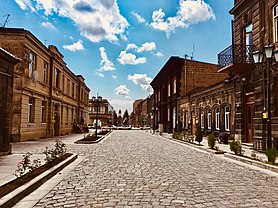      From top down, left to right; From top down, left to right;Abovyan street view • City Hall • Cathedral of Gyumri • Dzitoghtsyan Museum of National Architecture • Independence Square • Gyumri skyline | |
 Flag Flag Seal Seal | |
| Nickname: Hayrakaghak ("Father-city") | |
 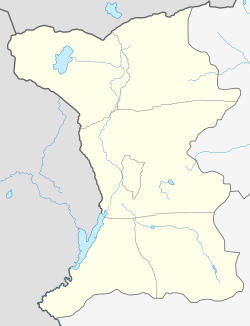 | |
| Coordinates: 40°47′22″N 43°50′51″E / 40.78944°N 43.84750°E / 40.78944; 43.84750 | |
| Country | Armenia |
| Province | Shirak |
| Founded as Kumayri by the Urartians | 8th century BC |
| Rebuilt as Alexandropol by Nicholas I of Russia | 1837 |
| Government | |
| • Type | Mayor–council |
| • Mayor | Samvel Balasanyan |
| Area | |
| • Total | 54 km (21 sq mi) |
| Elevation | 1,509 m (4,951 ft) |
| Population | |
| • Total | 121,976 |
| • Estimate | 112,600 |
| • Density | 2,300/km (5,900/sq mi) |
| Demonym | Gyumretsi |
| Time zone | UTC+4 (AMT) |
| Postal code | 3101-3126 |
| Area code | (+374) 312 |
| Vehicle registration | 45 am |
| Climate | Dfb |
| Website | www |
| Sources: Population | |
Gyumri (Template:Lang-hy, pronounced [ɡjumˈɾi]) is an urban municipal community and the second-largest city in Armenia, serving as the administrative center of Shirak Province in the northwestern part of the country. By the end of the 19th century, when the city was known as Alexandropol, it became the largest city of Russian-ruled Eastern Armenia with a population above that of Yerevan. The city became renowned as a cultural hub, while also carrying significance as a major center of Russian troops during Russo-Turkish wars of the 19th century.
The city underwent a tumultuous period during and after World War I. While Russian forces withdrew from the South Caucasus due to the October Revolution, the city became host to large numbers of Armenian refugees fleeing the Armenian Genocide, in particular hosting 22,000 orphaned children in around 170 orphanage buildings. It was renamed Leninakan during the Soviet period and became a major industrial and textile center in Soviet Armenia. The city's population rapidly grew to above 200,000 prior to the 1988 Spitak earthquake, when it was devastated, with the city's population being reduced to 121,976 as of the 2011 census. The city was renamed Gyumri under modern independent Armenia soon after the breakup of the Soviet Union, and post-earthquake reconstruction efforts continue.
Today, Gyumri continues to grapple with the lasting effects of the 1988 earthquake, but remains known as the cultural hub of Armenia due to the many artists and craftsman who originated from the city. The city is also in particular notable for the large Kumayri historic district that managed to mostly survive the 1988 earthquake, dating back mainly to the 19th century and being one of the few surviving places in the world with authentic urban Armenian architecture.
Name
| This section does not cite any sources. Please help improve this section by adding citations to reliable sources. Unsourced material may be challenged and removed. (December 2021) (Learn how and when to remove this message) |
The area of modern-day Gyumri was originally known as Kumayri (Template:Lang-hy) during the period of the Kingdom of Urartu. Over time, the name became disrupted through phonetic changes to Kumri, then Gumri, and finally Gyumri. In 1837, Gyumri was renamed Alexandropol after Czar Nicholas I's wife, Princess Alexandra Fyodorovna. Between 1924 and 1990, the city was known as Leninakan in honor of Vladimir Lenin. Following independence, the original name Kumayri was used until 1992, when Gyumri was chosen as the name of the city.
History
Classical antiquity and the ancient Armenian Kingdom

Archaeological excavations conducted throughout the Soviet period have shown that the area of modern-day Gyumri has been populated since at least the third millennium BC. The area was mentioned as Kumayri in the historic Urartian inscriptions dating back to the 8th century BC. Kumayri may be identical with the city of Gymnias or Gumnias mentioned by Xenophon in his Anabasis.
At the decline of the Urartu Kingdom by the second half of the 6th century BC, Kumayri became part of the Achaemenid Empire. The remains of a royal settlement found just to the south of Gyumri near the village of Beniamin dating back to the 5th to 2nd centuries BC, are a great example of the Achemenid influence in the region. However, at the beginning of the 5th century BC, Kumayri became part of the Satrapy of Armenia under the rule of the Orontids. An alternative theory suggests that Kumayri has been formed as an urban settlement in the late 5th century BC, ca. 401 BC, by Greek colonists.
Later in 331 BC, the entire territory was included in the Ayrarat province of Ancient Armenian Kingdom as part of the Shirak canton. Between 190 BC and 1 AD Kumayri was under the rule of the Artaxiad dynasty of Armenia. During the 1st century AD, Shirak was granted to the Kamsarakan family, who ruled over Kumayri during the Arsacid Kingdom of Armenia.
Medieval period
Following the partition of Armenia in 387 between the Byzantines and the Persians, and as a result of the fall of the Arsacid Kingdom of Armenia in 428, Shirak including Kumayri became part of the Sasanian Empire of Persia. In 658 AD, at the height of the Arab Islamic invasions, Kumayri was conquered during the Muslim conquest of Persia to become part of the Emirate of Armenia under the Umayyad Caliphate.
Kumayri was a significant and quite-developed urban settlement during the Middle Ages. According to the Armenian scholar Ghevond the Historian, the town was a center of the Armenian rebellion led by Artavazd Mamikonian against the Islamic Arab Caliphate, between 733 and 755. After 2 centuries of Islamic rule over Armenia, the Bagratids declared independence in 885 establishing the Bagratid Kingdom of Armenia. Kumayri entered e new era of growth and progress, particularly when the nearby city of Ani became the capital of the kingdom in 961. By the second half of the 10th century, Kumayri was under the influence of the Armenian Pahlavuni family, who were descendants of the Kamsarakans. The Pahlavunis had a great contribution in the progress of Shirak with the foundation of many fortresses, monastic complexes, educational institutions, etc.

After the fall of Armenia to the Byzantine Empire in 1045 and later to the Seljuk invaders in 1064. Under the foreign rulers, the town had gradually lost its significance during the following centuries, until the establishment of the Zakarid Principality of Armenia in 1201 under the Georgian protectorate. During the Zakarid rule, the Eastern Armenian territories, mainly Lori and Shirak, entered into a new period of growth and stability, becoming a trade center between the east and the west. After the Mongols captured Ani in 1236, Armenia turned into a Mongol protectorate as part of the Ilkhanate, and the Zakarids became vassals to the Mongols. After the fall of the Ilkhanate in the mid-14th century, the Zakarid princes ruled over Lori, Shirak, and Ararat plain until 1360 when they fell to the invading Turkic tribes.
By the last quarter of the 14th century, the Ag Qoyunlu Sunni Oghuz Turkic tribe took over Armenia, including Shirak. In 1400, Timur invaded Armenia and Georgia, and captured more than 60,000 of the survived local people as slaves. Many districts including Shirak were depopulated. In 1410, Armenia fell under the control of the Kara Koyunlu Shia Oghuz Turkic tribe. According to the Armenian historian Thomas of Metsoph, although the Kara Koyunlu levied heavy taxes against the Armenians, the early years of their rule were relatively peaceful and some reconstruction of towns took place.
Persian and Russian rules
Main article: Kumayri historic district
In 1501, most of the Eastern Armenian territories including Kumayri were conquered by the emerging Safavid dynasty of Iran led by Shah Ismail I. Soon after in 1502, Kumayri became part of the newly formed Erivan Beglarbegi, a new administrative territory of Iran formed by the Safavids. During the first half of the 18th century, Kumayri became part of the Erivan Khanate under the rule of the Afsharid dynasty and later under the Qajar dynasty of Persia.

In June 1804, the Russian forces controlled over Shirak region at the beginning of the Russo-Persian War of 1804 and 1813. Kumayri became officially part of the Russian Empire at the Treaty of Gulistan signed on 1 January 1813 between Imperial Russia and Qajar Persia.
During the period of Russian rule, Gyumri became one of the developing cities in the Transcaucasus. In 1829, in the aftermath of the Russo-Turkish War, there was a big influx of Armenian population, as around 3,000 families who had migrated from territories in the Ottoman Empire -in particular from the towns of Kars, Erzurum, and Doğubeyazıt- settled in and around Gyumri. The Russian poet Alexander Pushkin visited Gyumri during his journey to Erzurum in 1829.
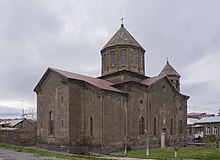
In 1837 Russian Tsar Nicholas I arrived in Gyumri and changed the name into Alexandropol. The name was chosen in honour of Tsar Nicholas I's wife, Princess Charlotte of Prussia, who had changed her name to Alexandra Fyodorovna after converting to Orthodox Christianity.
A major Russian fortress was built on the site in 1837. Alexandropol was finally formed as a town in 1840 to become the center of the newly established Alexandropol Uyezd, experiencing rapid growth during its first decade. In 1849, the Alexandropol Uyezd became part of the Erivan Governorate. The town was an important outpost for the Imperial Russian armed forces in the Transcaucasus where their military barracks were established (e.g., at Poligons, Severski, Kazachi Post). The Russians built the Sev Berd fortress at the western edge of the city during the 1830s in response to the Russo-Turkish War of 1828–1829.
Alexandropol had been quickly transformed to become one of the major centers of the Russian troops during the Russo-Turkish War of 1877–78. After the establishment of the railway station in 1899, Alexandropol witnessed significant growth and became the largest city in Eastern Armenia. By the end of the 19th century, Alexandropol was home to 430 shopping stores, several workshops, cultural institutions, a girl's gymnasium, a commercial school, a theater, and leather, bear, and soap enterprises.
Modern history
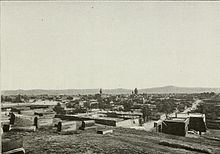
In 1902, the first bank in the city was opened. Until the sovietization of Armenia in 1920, Alexandropol had 31 manufacturing centers including beer, soap, textile, etc. After the October Revolution of 1917 and the Russian withdrawal from the South Caucasus, the Ottoman forces launched a new offensive capturing the city of Alexandropol on 11 May 1918, during the Caucasus Campaign in World War I. However, the Ottomans withdrew from the city on 24 December 1918, as stipulated by the Armistice of Mudros. On 6 December 1918, the Armenian army reoccupied the city.
The newly established Republic of Armenia proclaimed on 28 May 1918, included the city of Alexandropol. On 10 May 1920, the local Bolshevik Armenians aided by the Muslim population, attempted a coup d'état in Alexandropol against the Dashnak government of Armenia. The uprising was suppressed by the Armenian government on May 14 and its leaders were executed. However, during another Turkish invasion, Turkish troops attacked Alexandropol and occupied the city on 7 November 1920. Armenia was forced to sign the Treaty of Alexandropol on December 3 to stop the Turkish advance towards Yerevan, however a concurrent Soviet invasion led to the fall of the Armenian government on December 2. The Turkish forces withdrew from Alexandropol after the Treaty of Kars was signed in October 1921 by the unrecognized Soviet and Turkish governments.
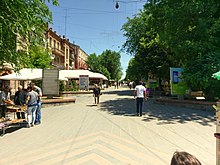
Under Soviet rule, the name of the city was changed in 1924 to Leninakan after the deceased Soviet leader Vladimir Lenin. The city suffered an earthquake in 1926, when many of its significant buildings were destroyed including the Greek church of Saint George.
Leninakan became a major industrial center in the Armenian Soviet Socialist Republic and its second-largest city, after the capital Yerevan. The city suffered major damage during the 1988 Armenian earthquake, which devastated many parts of the country. The earthquake occurred along a known thrust fault with a length of 60 kilometers (37 mi). Its strike was parallel to the Caucasus range and dipped to the north-northeast. Bruce Bolt, a seismologist and a professor of earth and planetary science at the University of California, Berkeley, walked the fault scarp in 1992 and found that the vertical displacement measured 1 m (3 ft 3 in) along most of the length with the southwest end reaching 1.6 m (5 ft 3 in).
The earthquake had a disastrous impact on the city, as many buildings are still not recovered. As of 2014, according to some news websites, between 4,000 and 5,000 residents of Gyumri remain homeless, although there are no official figures provided by the local authorities of the city.

At the time of the breakup of the Soviet Union, the city was renamed Kumayri between in 1990 until 1992 when it was finally given the name Gyumri. The Russian 102nd Military Base is located in the city.
Gyumri was celebrated as the Capital of Culture of the Commonwealth of Independent States for 2013. Major events took place in the city on 30 June 2013.
On 12 January 2015, Valery Permyakov, a serviceman from the Russian 102nd Military Base, murdered seven members of an Armenian family in Gyumri.
On 25 June 2016, Pope Francis delivered a Holy Mass at Gyumri's Vartanants Square. Catholicos of All Armenians Garegin II also took part in the ceremony.
Geography and climate

Gyumri is 126 kilometres (78 miles) north of the capital Yerevan at the central part of the Shirak plateau. It has an approximate height of 1,550 metres (5,090 feet) above sea level, the high altitude line being 1,500 metres (4,900 feet). The Akhurian River passes through the western suburbs. The Shirak plateau is surrounded with the Pambak Mountains from the east and Aragats volcanic range from the south. The city of Gyumri is 196 kilometres (122 miles) away from the Black Sea. The surrounding lands near the city are rich in tufa, basalt and clay.
Gyumri has a humid continental climate (Köppen Dfb), characterized by freezing and snowy winters where the minimum temperature in extreme spells can plummet to −41 °C or −41.8 °F. On the other hand, summer in Gyumri is relatively hot with temperatures reaching up to 38 °C or 100.4 °F. The annual precipitation averages 486 millimetres or 19.13 inches.
| Climate data for Gyumri, 1,523 metres (5,000 ft) asl (1981–2010 normals) | |||||||||||||
|---|---|---|---|---|---|---|---|---|---|---|---|---|---|
| Month | Jan | Feb | Mar | Apr | May | Jun | Jul | Aug | Sep | Oct | Nov | Dec | Year |
| Record high °C (°F) | 10.4 (50.7) |
13.9 (57.0) |
21.2 (70.2) |
32.4 (90.3) |
32.9 (91.2) |
33.5 (92.3) |
38.0 (100.4) |
38.2 (100.8) |
35.8 (96.4) |
30.3 (86.5) |
22.9 (73.2) |
14.0 (57.2) |
38.2 (100.8) |
| Mean daily maximum °C (°F) | −2.7 (27.1) |
−1.5 (29.3) |
4.6 (40.3) |
14.0 (57.2) |
17.9 (64.2) |
22.8 (73.0) |
27.1 (80.8) |
26.7 (80.1) |
24.0 (75.2) |
15.7 (60.3) |
7.2 (45.0) |
−0.2 (31.6) |
13.0 (55.3) |
| Daily mean °C (°F) | −8.2 (17.2) |
−6.8 (19.8) |
−0.8 (30.6) |
7.4 (45.3) |
11.4 (52.5) |
15.9 (60.6) |
20.1 (68.2) |
19.4 (66.9) |
15.8 (60.4) |
8.7 (47.7) |
2.0 (35.6) |
−4.8 (23.4) |
6.7 (44.0) |
| Mean daily minimum °C (°F) | −13.6 (7.5) |
−12 (10) |
−6.2 (20.8) |
0.8 (33.4) |
5.0 (41.0) |
8.9 (48.0) |
12.9 (55.2) |
12.1 (53.8) |
7.5 (45.5) |
1.6 (34.9) |
−3.2 (26.2) |
−9.3 (15.3) |
0.4 (32.6) |
| Record low °C (°F) | −41 (−42) |
−35 (−31) |
−30.1 (−22.2) |
−16 (3) |
−7.6 (18.3) |
−3.6 (25.5) |
1.4 (34.5) |
−1.1 (30.0) |
−4.1 (24.6) |
−14.6 (5.7) |
−23.8 (−10.8) |
−31.2 (−24.2) |
−41 (−42) |
| Average precipitation mm (inches) | 19.5 (0.77) |
31.8 (1.25) |
24.0 (0.94) |
46.3 (1.82) |
78.3 (3.08) |
63.4 (2.50) |
47.2 (1.86) |
32.9 (1.30) |
21.1 (0.83) |
42.2 (1.66) |
32.5 (1.28) |
20.2 (0.80) |
459.4 (18.09) |
| Average precipitation days (≥ 1 mm) | 5.5 | 5.5 | 5.8 | 8.7 | 13.5 | 10.6 | 6.6 | 6.4 | 3.6 | 6.3 | 6.6 | 5.1 | 84.2 |
| Source 1: Météo climat stats Météo Climat | |||||||||||||
| Source 2: Climatebase.ru | |||||||||||||
Demographics
Population
The population of Gyumri has gradually grown since 1840 after gaining the status of town. A huge decline of the population was due to the disastrous earthquake of 1988. The residents here have a distinct look and style, and a boundless pride in their city. The dialect of Gyumri is a variant of Karin dialect, closely related to Western Armenian.
| Year | Armenians | Russians | Others | TOTAL | |||
|---|---|---|---|---|---|---|---|
| 1829 | 600 | ||||||
| 1830 | 4,000 | ||||||
| 1831 | 3,194 | 92.7% | — | 250 | 7.3% | 3,444 | |
| 1850 | 15,000 | ||||||
| 1873 | 19,129 | 95.8% | 847 | 4.2% | 19,976 | ||
| 1886 | 22,921 | 94.6% | 1,309 | 5.4% | 24,230 | ||
| 1897 | 21,771 | 71.1% | 5,157 | 16.8% | 3,668 | 12.1% | 30,616 |
| 1908 | 33,723 | ||||||
| 1914 | 51,316 | ||||||
| 1916 | 45,646 | 88.0% | 3,306 | 6.4% | 2,146 | 4.1% | 51,874 |
| 1919 | 51,000 | ||||||
| 1922 | 43,658 | 97.8% | 998 | 2.2% | 44,656 | ||
| 1923 | 58,600 | ||||||
| 1926 | 37,520 | 88.7% | 3,634 | 8.6% | 1,159 | 2.7% | 42,313 |
| 1931 | 50,483 | 95.1% | 2,592 | 4.9% | 53,075 | ||
| 1939 | 62,159 | 91.8% | 4,249 | 6.3% | 1,321 | 1.9% | 67,729 |
| 1959 | 100,960 | 93.1% | 5,630 | 5.2% | 1,856 | 1.7% | 108,446 |
| 1970 | 164,966 | ||||||
| 1984 | 222,000 | ||||||
| 1989 | 122,587 | ||||||
| 2001 | 150,917 | ||||||
| 2011 | 121,976 | ||||||
| 2018 | 114,500 | ||||||


Religion





The majority of the population in Gyumri belongs to the Armenian Apostolic Church. The Cathedral of the Holy Mother of God of Gyumri -also known as the Cathedral of the Seven Wounds of the Holy Mother of God- is the seat of the Diocese of Shirak of the Armenian Church.
The Armenian Catholic Church is a minority in Armenia and is under the jurisdiction of the Ordinariate of Armenia, Georgia, Russia, and Eastern Europe, based in Gyumri. There are around 16,000 Armenian Catholics in the Shirak Province. The seat of the Ordinariate for Armenia, Georgia, Russia, and Eastern Europe for the Armenian Catholic Church is the Cathedral of the Holy Martyrs in Gyumri.
The presence of the small Russian Orthodox community along with the Russian military base personnel is marked with the Saint Alexandra the Martyr's Church (within the Russian base), the Church of Saint Michael the Archangel and the Church of Saint Arsenije.
However, many historic churches in Gyumri were either ruined or destroyed, including:
- Dprevank Monastery and the Basilic Church of old Kumayri dating back to the 7th century: it was the first ever church built in old Kumayri. However, the monastic complex was completely destroyed in 1852, during the construction of Russian military barracks.
- Saint George Greek Orthodox Church, opened in 1850. It was completely destroyed in 1933–34.
- Holy Mother of God Armenian Catholic Church, built between 1849 and 1854. Although standing, the building was turned into a private residence during the Soviet period.
- Russian church of the Seversky 18th Dragoon Regiment, built in 1856. It was consecrated in 1901 and destroyed during the Soviet period.
- Russian church of the Caucasian 7th Rifle Regiment, built during the 1850s. It was completely destroyed during the Soviet period.
- Russian church of the Caucasian 8th Rifle Regiment, built during the 1850s. It was completely destroyed during the Soviet period.
- Russian church of the Baku 154th Infantry Regiment, built during the 1850s. It was completely destroyed during the Soviet period.
As of 2017, Gyumri is home to the following church buildings:
- Saint Alexandra the Martyr's Church within the complex of the Russian military base, built in 1837–42. It was completely renovated and reopened on May 8, 2008.
- Church of the Holy Saviour or Surp Amenaprkich, constructed between 1859–1873: designed to resemble the Cathedral of Ani. The church was heavily damaged by the 1988 Spitak earthquake and is currently under reconstruction.
- Surp Nshan or Holy Sign Church: Opened in 1870.
- Saint Gregory the Illuminator's Church, built between 1875 and 1880.
- Saint Michael the Archangel Russian Orthodox Church, locally known as Plplan Zham (the Shimmering Chapel), built between 1875 and 1880.
- Cathedral of the Holy Mother of God: also known as Seven Wounds of the Holy Mother of God, constructed between 1873–1884. Currently, it is the seat of the Diocese of Shirak of the Armenian Apostolic Church.
- Saint Arseny Russian Orthodox Church, built during the 1870s and opened in 1910. It is locally known as the church of Kazachi Post.
- Saint Hripsime Chapel, opened in 1992.
- Saint Jacob of Nisibis Church: or Surp Hakob Mtsbinetsi Church, opened in 2005.
- Surp Sarkis Chapel, built in 2008 and opened in 2011.
- Surp Minas Chapel, opened in 2013.
- Cathedral of the Holy Martyrs of the Catholic Armenians, opened in 2015.
Culture
Museums and art


Gyumri is home to many prominent museums of Armenia, including the House-Museums of sculptor Sergey Merkurov, poets Avetik Isahakyan and Hovhannes Shiraz, and actor Mher Mkrtchyan. The Aslamazyan Sisters Gallery, built in the 1880s, is home to more than 700 drawings, paintings and other works of the Aslamazyan sisters who were the Soviet-era artists. The Dzitoghtsyan Museum of Social Life and National Architecture of Gyumri is an old mansion, housing collections related to both history and the everyday-life of Gyumri, as well as paintings and other works of art.
Throughout centuries, Kumayri-Gyumri was labelled as the "city of crafts and arts", being famous for its schools, theaters and gusans.

In 1865, an amateur theatre group in Gyumri performed H. Karinyan's "Shushanik". In 1912, Gyumri was home to the first opera show ever staged in Armenia, when composer Armen Tigranian presented Anoush to the public in Alexandropol. In 1923, the first Armenian opera theatre was opened in Gyumri (where the first ballet performance in Armenia took place in 1924), while the Vardan Ajemian State Drama Theatre was founded in 1928. Prominent directors Ruben Simonov and Vardan Ajemian, actors Mher Mkrtchyan, Azat Sherents and Varduhi Varderesyan worked in theatre. The theatre's new building was opened in 1972. The artistic director is Nikolay Tsaturyan. Gyumri is known for its 19th-century architecture and urban constructions.
The first printing house of Gyumri was founded in 1876 by G. Sanoyan and operated until 1918. It published literary works (including Avetik Isahakyan's first book), calendars, textbooks. Another printing house, Ayg (founded 1892), published historical books and the first periodical of Gyumri, Akhuryan.
Gyumri is home to the Gyumri Biennial, organized by the artist Azat Sargsyan and the Gyumri Center of Contemporary Art (GCCA). Gyumri was officially declared Commonwealth of Independent States cultural capital in 2013.
Music

The city of Gyumri has a great contribution in Armenian folk music. Throughout the 19th century, Alexandrapol was considered the center of folk and traditional Armenian music. The musical culture of Alexandrapol has greatly influenced the art of Jivani, who is considered the founder of modern Armenian folk music during the 19th century. Another 19th-century ashik Sheram who was born in Alexandropol, is one of the earliest gusans of traditional Armenian music in the modern history of Armenia. He is one of the most celebrated Armenian composers of folk music.
The mystic philosopher of Alexandropol George Gurdjieff has produced many influential works of music during the 20th century.
Different genres of music became popular in the city during the 2nd half of the 20th century. Rock, folk rock and ethnic rock are widely popular through the local famous rock band Bambir, active since 1978.
In 1986, the Gyumri State Orchestra of Folk Instruments was founded, followed by the Gyumri State Symphonic Orchestra founded in 1993. In 1997, the KOHAR Symphony Orchestra and Choir was founded in Gyumri through the efforts of the Lebanese-Armenian philanthropist Harout Khatchadourian. Soon after, KOHAR became one of the most celebrated choirs in Armenia as well as throughout the Armenian diaspora.
Influenced by Gurdjieff, the Armenian musician Levon Eskenian founded The Gurdjieff Ensemble in 2008. The award-winning ensemble gathers many of Armenia's leading practitioners of traditional music, performing on duduk, sring, kamancha, oud, kanōn, santur, tar, saz, daf, dhol, and tombak.
The Renaissance international music festival of Gyumri is held annually since 2009.
In 2011 WhoCares, a supergroup formed by Ian Gillan and Tony Iommi with the participation of a great number of rock artists, raised money to build the "Octet" music school in Gyumri (opened two years later).
Monuments


- Kumayri historic district: is the old part of Gyumri with its unique architecture. It has more than a thousand buildings dating back to the 18th and 19th centuries. The district is one of few places in the Republic of Armenia, and the world, with authentic urban Armenian architecture. Almost all the structures of the Kumayri district have survived the two major earthquakes in 1926 and 1988 respectively. The historic district of Kumayri occupies the central and western part of modern-day Gyumri.
- Sev Berd or the Black Fortress (Template:Lang-hy; Template:Lang-ru, Chornaya Krepost): is an abandoned Russian imperial fortress in Gyumri built between 1834 and 1847, located 8 kilometres (5.0 mi) east of the closed border with Turkey. It was erected in response to the Russo-Turkish War of 1828–1829. Currently, it is a national cultural heritage monument of Armenia, used as an art and cultural center
- The monumental statue of Mother Armenia erected in 1975.
- Vartanants Square is the central town square of Gyumri.
- Independence Square.
- Charles Aznavour Square.
- Garegin Nzhdeh Square.
- Gyumri Central Park, founded during the 1920s on the site of the old cemetery of the city.
- Statue of Avetik Isahakyan (Gyumri)
The restoration process of the damaged buildings of Gyumri has been spearheaded by Earthwatch to preserve the city's unique architecture.
In spite of suffering severe damages during the disastrous earthquake in December 1988, Gyumri is still preserving its own architectural characteristics.
Local customs

The residents are Gyumri are widely known as conservative people. Traditions and local customs are widely preserved by the local citizens. It is very common among Armenians to refer to the dignity of Gyumri (Template:Lang-hy Gyumrva tasib).
Gyumri is considered to be the "laughter and humor capital" of Armenia. The jokes and anecdotes of local humorists like Jgher Khachik and Poloz Mukuch are widely known by the local citizens. Many works have been published to narrate about the legacy and heritage of the humor in Gyumri.
The city celebrates the "Gyumri Day" annually on the first Sunday of October. It is marked with many cultural and entertainment activities.
Media
Gyumri has 4 regional TV stations:
- Tsayg TV, operating since 1991.
- Shirak Public TV, operating since 1992.
- Gala TV, operating since 2005.
- Shant, operating since 1994.
Shrjapa, a weekly, is the local newspaper of Gyumri.
Transportation
Air transportation

Gyumri is served by the international Shirak Airport, about 5 kilometres (3.1 miles) to the southeast of the city center. It was inaugurated in 1961 and is the second largest airport in Armenia. At the beginning of 2006, the government of Armenia felt the importance of having a second international airport, when adverse weather conditions meant that many flights had to be diverted from Yerevan's Zvartnots International Airport into Gyumri's Shirak Airport. New air traffic control equipment allowed airport workers to identify planes in a 400-kilometre (250-mile) radius.
Following moderate use in 2005 and 2006 during which annual passenger traffic was at about 46,000 and several hundred aircraft movements took place each year, the airport's activity quickly declined again to the point where in 2016 passenger traffic amounted to only 12,421 and a mere 54 aircraft movements took place. However, in the beginning of 2017, as part of new efforts to develop Gyumri and its tourism industry, the government focused on revitalizing the airport. Multiple new airlines began operating flights to the airport, including Taron Avia, a new Armenian airline based in Gyumri. In order attract more customers, the Ministry of Nature Protection made meteorological services free for all airlines flying to Gyumri, lowering ticket costs. The Gyumri Technology Center also participated in helping revitalize the airport by adding interior design details to improve the airport's look.
Railway
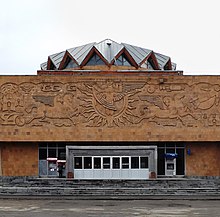
The railway junction of Gyumri is the oldest and the largest one in Armenia. It was formed in 1897 and the first railway link to Alexandropol that connected the city with Tiflis was completed in 1899. The rail line was then extended from Alexandropol to Yerevan (in 1902), Kars (in 1902), Jolfa (in 1906), and Tabriz. As a result, Alexandropol became an important rail hub.
As of 2017, the Gyumri Railway Station operates regular trips to Yerevan and Batumi. The South Caucasus Railway CJSC, is the current operator of the railway sector in Armenia.
Public vans and taxis
Public transport is dominated by the private sector in Gyumri. Public transit is mainly served by public vans, locally-known as marshrutka. Most of the marshrutkas Russian-made GAZelle vans with 13 seats that operate with certain routes and stops. As of 2017, the one-way trip fee is AMD 100 (around US$0.21). Passengers need to pay the money directly to the driver when getting out of the vehicle, with no established ticketing system.
The central station of the city serves as bus terminal for inter-city transport, serving outbound routes towards other major cities and towns in Armenia, as well as cities in Georgia. The M-7 Motorway passes across the Shirak Province from east to west, connecting the city of Gyumri with the rest of Armenia.
Armenia is among the top 10 safest countries where one can wander around and go home alone safely at night. Taxis are available in the city at any time of the day or night.
Economy

During the pre-Soviet era, Alexandropol was considered the third-largest trade and cultural center in Transcaucasia after Tiflis and Baku (Yerevan would not rise to prominence until being proclaimed as the capital of independent Armenia in 1918 and the Armenian SSR in 1920). At the end of the 19th century, the population of Alexandropol had grown to 32,100 inhabitants, with a majority of Armenians.
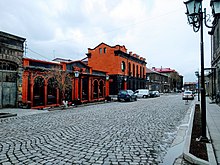
The economy of Gyumri is mainly based on industry and construction. However, tourism and banking services are also among the developed sectors in the city.
The industrial sector in the provincial center Gyumri includes the production of building materials (tufa and basalt), hosiery and textile manufacturing, food processing and dairy products, alcoholic drinks, electronic machines, etc. The largest industrial plant in Gyumri is the Gyumri-Beer Brewery opened in 1972. The factory produces a variety of lager beer under the brands Gyumri, Ararat and Aleksandrapol. The city is also home to the "Factory of Bending Machinses" opened in 1912, the "Arshaluys" hosiery manufacturing enterprise established in 1926, the "Karhat" machine tools plant opened in 1959, the "Chap Chemical LLC" since 1999, the "Armtex Group" clothing factory since 2000, and the "Lentex" hosiery manufacturing plant is operating since 2001. Other industrial firms of the city include the "Aleqpol" factory for dairy products, the "Anusharan" confectionery plant, and the "Gold Plast" plant for building materials.
The nearby village of Akhuryan is home to the "Lusastgh-Sugar" factory (opened in 2010), the largest sugar producers in the Southern Caucasus region.
Education
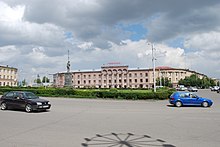

Gyumri has a large number of educational institutions, following the capital Yerevan in the number of educational institutions. It is considered the cultural and educational center of northern Armenia.
As of 2017, Gyumri is home to the following higher educational centers:
- Shirak State University named after Mikael Nalbandian, opened in 1934 and is currently home to 7 faculties.
- Gyumri campus of the National Polytechnic University of Armenia, operating since 1959 with 2 faculties:
- Faculty of Technologies and sectoral economics,
- Faculty of Natural sciences and communication systems.
- Gyumri campus of Komitas State Conservatory of Yerevan, operating since 1988.
- Progress Gyumri University, opened in 1990.
- Shirakatsy campus of Haybusak University of Yerevan, operating since 1991.
- Imastaser Anania Shirakatsi University, opened in 1992.
- Gyumri campus of Armenian State University of Economics, operating since 1997.
- Gyumri campus of Yerevan State Academy of Fine Arts, operating since 1997.
- Gyumri campus of Yerevan State Institute of Theatre and Cinematography, operating since 1997.
In 2014, the Gyumri Technology Center was opened in the city, in an attempt to turn Gyumri into a regional and international center of information and high technologies.
The Gyumri branch of Tumo Center for Creative Technologies was opened in May 2015, following a fundraising initiative by Shant TV. It will move to the old theatre building of Gyumri upon the completion of the reconstruction process, expected in June 2019.
As of 2017, the city is home to 47 public education schools, 23 pre-school kindergartens, as well as 7 special schools for music.
Sport
Football
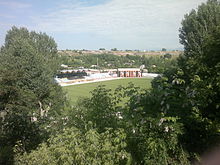
Gyumri is home to the Armenian football club FC Shirak. They play their home games at the Gyumri City Stadium, the oldest football stadium in Armenia dating back to 1924. Shirak are one of the most popular football teams in Armenia, having won the championship of the Armenian Premier League four times, with the most recent one in the 2012–13 season. Shirak have also won the Armenian Independence Cup once. The native of Gyumri and former Shirak player Artur Petrosyan was the all-time leading scorer for the Armenia national football team until his record was surpassed by Henrikh Mkhitaryan in 2013.
Aragats FC was the second football club that represented the city. However, the club was dissolved in 2002 due to financial difficulties.

The Gyumri Football Academy of the Football Federation of Armenia was opened on 13 September 2014. It is home to four natural-grass and two artificial turf regular-sized football training pitches.
Futsal
Futsal is also very popular in Gyumri. Being one of the most successful Futsal teams in Armenia, FC Gyumri played at the Armenian Futsal Premier League. Starting from 2017–18 season, FC Gyumri became known as Shirak Futsal, representing the futsal branch of FC Shirak. The newly founded Sh.S.U. Futsal -representing the Shirak State University- will also participate in the domestic league competition. The futsal teams of Gyumri regularly play their home games at the Armen Sargsyan Sports Hall, located in the Ani district at the northwest of the city.
Olympic individual sports
Gyumri has made a major contribution to the sporting life of Armenia. Many Olympic and world champion wrestlers, weightlifters and boxers are from Gyumri. The city is notable for its worldwide champions in individual sports, such as Robert Emmiyan in long jump, Yurik Vardanyan and Nazik Avdalyan in weightlifting and Artur Aleksanyan in Greco-Roman wrestling.
Many special sport schools are serving the young generation of Gyumri such as the Robert Emmiyan school of athletics, Levon Ishtoyan football school, Tigran Petrosian school of chess, Ludvig Mnatsakanyan school of winter sports, Artur Aleksanyan school of wrestling, Yurik Vardanyan school of weightlifting, Aleksan Haobyan school of tennis and table tennis, as well as other special schools for boxing, artistic gymnastics, sambo-judo, fencing, and chess. The city is also home to the Gyumri Swimming Complex. The National Federation of Black Belts of Aikido (NFBBA) is based in Gyumri since its establishment in 2012.
The Gyumri State Sports College of Olympic Reserve and Gyumri School of Sport Masters are among the prominent sport schools in Armenia that produced many champions in several individual sports.
Twin towns – sister cities

Gyumri is twinned with:
 Alexandria, United States (1990)
Alexandria, United States (1990) Ashfield, United Kingdom (1998)
Ashfield, United Kingdom (1998) Białystok, Poland (2013)
Białystok, Poland (2013) Créteil, France (2009)
Créteil, France (2009) Domodedovo, Russia (2014)
Domodedovo, Russia (2014) Glendale, United States (2015)
Glendale, United States (2015) Halle, Germany (2020)
Halle, Germany (2020) Mozdok, Russia (2011)
Mozdok, Russia (2011) Nardò, Italy (2013)
Nardò, Italy (2013) Osasco, Brazil (2006)
Osasco, Brazil (2006) Petah Tikva, Israel (2019)
Petah Tikva, Israel (2019) Pitești, Romania (2012)
Pitești, Romania (2012) Plovdiv, Bulgaria (2004)
Plovdiv, Bulgaria (2004) Tver, Russia (2022)
Tver, Russia (2022) Xi'an, China (2013)
Xi'an, China (2013)
People
See also: Category:People from Gyumri- Artur Aleksanyan, Olympic, European and world champion in wrestling
- Mourad Amirkhanian, opera singer (bass-baritone)
- Mkrtich Armen, Armenian novelist
- Mkrtich Arzumanyan Armenian actor
- Mariam Aslamazian, Soviet-Armenian painter
- Khachatur Avetisyan, Armenian composer
- Nazik Avdalyan, weightlifting world champion
- Olga Chekhova, Russian actress
- Robert Emmiyan, European long jump record holder
- Bagrat Galstanyan, Armenian theologian and cleric
- Alik Gunashian, popular singer
- George Gurdjieff, mystic and philosopher
- Tigran Hamasyan, jazz pianist and composer
- Avetik Isahakyan, Armenian poet
- Mnatsakan Iskandaryan, wrestling Olympic champion (1992)
- Levon Ishtoyan, footballer, Soviet champion with FC Ararat (1973)
- Levon Julfalakyan, wrestling Olympic champion (1988)
- Araksya Karapetyan, Armenian-American TV anchor
- Emil Kazaz, Armenian-American sculptor
- Karekin Khajag, journalist, victim of the genocide
- Edmond Keosayan, film director
- Hayk Kotanjian, Armenian military diplomat
- Shushanik Kurghinian, Armenian influential writer
- Vazgen Manukyan, former Prime Minister of Armenia
- Flora Martirosian, Armenian folk songs performer
- Sergey Merkurov, Soviet sculptor
- Israel Militosyan, weightlifting Olympic champion (1992)
- Ashot Mkhitaryan, weightlifting trainer
- Levon Mkrtchyan, film director
- Mher Mkrtchyan, renowned actor
- Albert Nalchajyan, psychologist and writer
- Artavazd Peleshyan, film director
- Artur Petrosyan, footballer, manager of the Armenian team
- Samvel Sevada, painter and poet
- Sheram, gusan, poet and composer
- Hovhannes Shiraz, Armenian poet
- Nariné Simonian French-Armenian musical director
- Karen Smbatyan, Armenian painter
- Svetlana Svetlichnaya, actress
- Armen Tigranian, opera composer
- Nikoghayos Tigranian, composer and ethnomusicologist
- Gennady Timchenko, Russian businessman
- Seda Tutkhalyan, Russian gymnast
- Valmar, Armenian painter
- Yurik Vardanian, weightlifting Olympic champion (1980)
- Boris Vladimirov, Soviet Army officer
- Mkhitar Manukyan, world wrestling champion
- Meline Daluzyan, european weightlifting champion
- Tigran Vardan Martirosyan, european weightlifting champion
- Nazik Avdalyan, european and world weightlifting champion
- Arsen Julfalakyan, european and world wrestling champion
- Tigran Gevorg Martirosyan, world weightlifting champion
- Vahan Bichakhchyan, Armenian footballer
See also
Notes
- Classical spelling: Գիւմրի
- Template:Lang-ru; Template:Lang-hy
- Template:Lang-hy, pronounced [lɛninɑˈkɑn]; Template:Lang-ru, pronounced [lʲɪnʲɪnəˈkan]
References
- "Number of de Jure Population of the Republic of Armenia as of October 1, 2019 (Armenian) / Statistical Committee of the Republic of Armenia".
- "Armstats : Population" (PDF). Armstat.am. Retrieved 15 December 2014.
- ^ "History". Visit Gyumri. Retrieved 2022-07-18.
- "Our history". www.gyumricity.am. Retrieved 2022-07-18.
- "Kumayri infosite". Cimmerian. Archived from the original on 6 November 2012. Retrieved 14 June 2015.
- Garsoïan, Nina G. (1984). "The Early-Mediaeval Armenian City: An Alien Element?". JANES. 16 (1): 68.
- "Gyumri Armenia Britannica.com". Encyclopædia Britannica. Retrieved 14 June 2015.
- "Shiral Regional Museum". Archived from the original on 2016-09-21. Retrieved 2016-10-16.
- Bournoutian. Concise History, p. 75.
- Ter-Ghevondyan. Arab Emirates, p. 45.
- (in Armenian) Arakelyan, Babken N. "Բագրատունյաց թագավորության բարգավաճումը" ("The Flourishing of the Bagratuni Kingdom"). History of the Armenian People. vol. iii. Yerevan, Armenian SSR: Armenian Academy of Sciences, 1976, p. 53.
- Arakelyan. "Bagratuni Kingdom", pp. 52–58.
- ^ "The Turco-Mongol Invasions". Rbedrosian.com. Retrieved 2012-05-22.
- Kouymjian, Dickran (1997), "Armenia from the Fall of the Cilician Kingdom (1375) to the Forced Migration under Shah Abbas (1604)" in The Armenian People From Ancient to Modern Times, Volume II: Foreign Dominion to Statehood: The Fifteenth Century to the Twentieth Century, ed. Richard G. Hovannisian, New York: St. Martin's Press, p. 4. ISBN 1-4039-6422-X.
- Steven R. Ward. Immortal, Updated Edition: A Military History of Iran and Its Armed Forces pp 43. Georgetown University Press, 8 January 2014 ISBN 1626160325
- "Ալեքսանդրապոլի գավառ. տարածքը և բնակչությունը 1831-1918 թվականներին" [The Alexandropol uezd: area and population in 1831–1918]. ANI Armenian Research Center. 27 November 2021. Retrieved 10 July 2022.
- Der Matossian 2020, p. 15.
- Hovannisian 1967, p. 198.
- Bolt, Bruce (August 2005), Earthquakes: 2006 Centennial Update – The 1906 Big One (Fifth ed.), W. H. Freeman and Company, pp. 65–67, ISBN 978-0716775485
- "Անօթեւանների թվաքանակը, քաղաքապետարանի չիրականացրած հաշվառումն ու Սուքիաս Ավետիսյանի "հուզմունքը"". March 29, 2014.
- "Modern history of Gyumri". Archived from the original on 2018-10-23. Retrieved 2016-02-02.
- Գյումրին պաշտոնապես հայտարարվել է 2013-ին ԱՊՀ մշակութային մայրաքաղաք. Archived from the original on 22 September 2013. Retrieved 16 July 2013.
- Karapetyan, Armen (26 January 2015). "Armenia: Murder Case Strains Relations with Moscow". Institute for War and Peace Reporting.
- "Pope Francis' Mass begins in Gyumri". armenpress.am.
- "Moyennes 1981-2010 Arménie" (in French). Retrieved 11 November 2019.
- "Météo Climat stats for Gumri". Météo Climat. Retrieved 11 November 2019.
- "Climatebase: Gyumri, Armenia". Climatebase. 2019.
- Hovannisian, Richard, ed. (2003). Armenian Karin/Erzerum. Costa Mesa, California: Mazda Publ. p. 48. ISBN 9781568591513.
Thus, even today the Erzerum dialect is widely spoken in the northernmost districts of the Armenian republic as well as in the Akhalkalak (Javakheti; Javakhk) and Akhaltskha (Akhaltsikh) districts of southern Georgia
- ^ Korkotyan, Zaven (1932). Խորհրդային Հայաստանի բնակչությունը վերջին հարյուրամյակում (1831-1931) [The population of Soviet Armenia in the last century (1831–1931)] (PDF) (in Armenian). Yerevan: Pethrat. pp. 164–167. Archived from the original (PDF) on 2 February 2022.
- "Weekly – . ". Demoscope.ru. Retrieved 15 December 2014.
- Кавказский календарь на 1910 год [Caucasian calendar for 1910] (in Russian) (65th ed.). Tiflis: Tipografiya kantselyarii Ye.I.V. na Kavkaze, kazenny dom. 1910. p. 178. Archived from the original on 15 March 2022.
- Кавказский календарь на 1917 год [Caucasian calendar for 1917] (in Russian) (72nd ed.). Tiflis: Tipografiya kantselyarii Ye.I.V. na Kavkaze, kazenny dom. 1917. pp. 214–221. Archived from the original on 4 November 2021.
- "Ленинаканский уезд 1926". Ehtno-kavkaz.narod.ru. Retrieved 15 December 2014.
- ^ "население армении". Ethno-kavkaz.narod.ru. Retrieved 15 December 2014.
- "Демоскоп Weekly - Приложение. Справочник статистических показателей". www.demoscope.ru. Retrieved 2022-02-12.
- "Демоскоп Weekly - Приложение. Справочник статистических показателей". 2012-01-18. Archived from the original on 18 January 2012. Retrieved 2022-02-12.
- Diocese of Shirak Archived 2014-03-18 at the Wayback Machine
- "The Eparchy of Armenia & Oriental Europe of the Armenian Catholic Church". Armeniancatholic.org. Archived from the original on 20 October 2010. Retrieved 15 December 2014.
- "Հաղթանակի պողոտայում սկսվել են Հայ կաթողիկե եկեղեցու շինաշախատանքները". Old.tsayg.am. Archived from the original on 15 December 2014. Retrieved 15 December 2014.
- "Religious organizations in Armenia" (PDF). Armstat.am. Retrieved 15 December 2014.
- "Դե եսիմ..."
- ^ Tatul Hakobyan. "Gyumri has preserved the aura and architecture of the 19th century". Reporter.am. Archived from the original on 21 December 2014. Retrieved 15 December 2014.
- A. Bakhchinyan. Հայերը համաշխարհային պարարվեստում (Armenians on the International Dance Scene), Yerevan, 2016. p. 13
- Concise Armenian Encyclopedia, Ed. by acad. K. Khudaverdyan, Yerevan, Vol. 2, p. 763
- Art and Asia Pacific Almanac – Volume 5 – Page 92
- "Gyumri officially declared CIS cultural capital in 2013". Armenianow.com. Retrieved 15 December 2014.
- "TheBambir.com is available at DomainMarket.com". TheBambir.com is available at DomainMarket.com.
- "KOHAR – Symphony Orchestra & Choir".
- "Gurdjieff Ensemble". Gurdjieff Ensemble. 11 April 2016.
- "Silver Impala Award". Ian Gillan official website. Retrieved 2013-02-20.
- "Գյումրու Ալեքսանդրովսկի՝ ներկայում Աբովյան փողոցի մի հատվածը կրելու է ամերիկահայ բարերար Քըրք Քըրքորյանի անունը". Hetq.am. 18 May 2016.
- Kaghzvantsian, Satenik (22 June 2015). "U.S.-Armenian Tycoon Remembered At Gyumri Church Service". «Ազատ Եվրոպա/Ազատություն» ռադիոկայան.
- "Serzh Sargsyan walked through Gyumri's 'fantastic' streets and had dinner in newly built guest houses | www.aravot-en.am".
- Sev Berd or the Black Fortress of Gyumri, atb.am; accessed 20 November 2015.
- Georgia Brown (2 May 2007). Andy Burnham (ed.). "Rebuilding Armenia". The Guardian.
- ""Հալալ է". գյումրեցիների գնահատականը մեկդարյա "Անուշ"-ի առաջնախաղին". September 3, 2012.
- "Տավուշում հայկական կողմը նախազգուշացնող կրակ է բացել. Արծրուն Հովհաննիսյան". January 7, 2020.
- ""Սարի պես բանցր Գյումրին" եւ նրա հումորի լեգենդները". September 13, 2013.
- "armats". Armats.com. Archived from the original on 23 September 2015. Retrieved 15 December 2014.
- "arka". Arka.am. 23 January 2017. Retrieved 27 July 2017.
- "panorama". panorama.am. Retrieved 27 July 2017.
- About company
- "Armenia among the top 10 safest countries". Banks.am.
- "1837թ. Գյումրին վերանվանվում է Ալեքսանդրապոլ. (պատմություն)". 1in.am. Archived from the original on 7 September 2013. Retrieved 15 December 2014.
- "GYUMRI BEER". Gyumribeer.am. Retrieved 15 December 2014.
- "Faculties of Gyumri campus". Archived from the original on 2016-09-26. Retrieved 2016-10-16.
- "Gyumri Technology Center:Vision/Mission". Archived from the original on 2017-11-15. Retrieved 2016-02-04.
- "Gyumri Tumo Center to Open in Spring 2015". Asbarez. 2014-11-14.
- "President Serzh Sargsyan attends Gyumri Day-dedicated events - Domestic visits - Updates - The President of the Republic of Armenia". www.president.am.
- "ՆՈՐՈՒԹՅՈՒՆՆԵՐ – 2013/08/21". Armsport.am. Archived from the original on 1 June 2019. Retrieved 15 December 2014.
- "Sister cities". Gyumri. Retrieved 2020-07-02.
- "Hauptausschuss für Städtepartnerschaft mit Gjumri in Armenien" (in German). Du bist Halle. 2020-05-20. Retrieved 2020-07-02.
- "Armenian Genocide Memorial to be unveiled in Israel". Armenpress. 2019-10-10. Retrieved 2020-07-02.
Bibliography
- Der Matossian, Bedross (2020). The First Republic of Armenia (1918-1920): On its Centenary: Politics, Gender, and Diplomacy. Fresno: The Press at California State University. ISBN 978-0912201672. OCLC 1162163551.
- Hovannisian, Richard G (1967). Armenia on the Road to Independence, 1918. Berkeley: University of California Press. ISBN 978-0520005747. OCLC 1028172352.
External links
| Places of worship |  | |
|---|---|---|
| Landmarks | ||
| Museums and culture |
| |
| Science and Education |
| |
| Sports and recreation |
| |
| Transportation | ||
| Capital: Gyumri | ||
| Urban settlements |  | |
| Akhuryan Municipality | ||
| Amasia Municipality | ||
| Ani Municipality | ||
| Artik Municipality | ||
| Ashotsk Municipality | ||
| Cities and towns in Armenia | ||
|---|---|---|
| Aragatsotn |   | |
| Ararat | ||
| Armavir | ||
| Gegharkunik | ||
| Kotayk | ||
| Lori | ||
| Shirak | ||
| Syunik | ||
| Tavush | ||
| Vayots Dzor | ||
| Capital city | ||